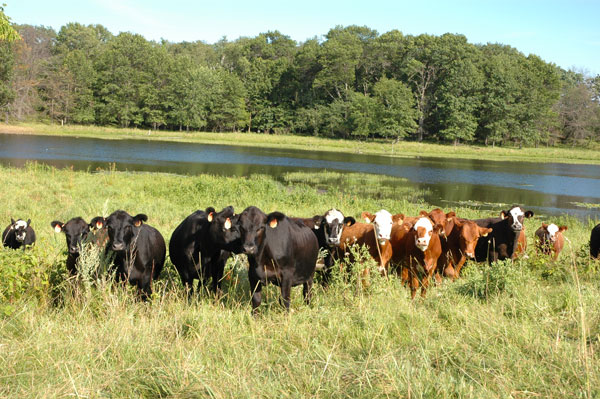Blue-green algae blooms can devastate cattle producers.
August 20, 2015

It seems to happen every summer about this time, and the effects can be devastating if it happens to you. As the summer days roll into the hot, dry, calm days common in July and August, it creates ideal conditions for blooms of blue-green algae. Blue-green algae often occur in stagnant ponds or dugouts with elevated nutrient levels, forming large colonies that appear as scum on or just below the water surface. The problem? Cyanobacteria. Live cyanobacteria is green and turns blue after it dies and dries on the surface or shoreline.
Some species of cyanobacteria can be toxic when ingested by livestock and wildlife. Toxicity is dependent on the specie of animal consuming the water, and the concentration and the amount of water ingested. Cyanobacteria produces neuro and liver toxins. Signs of neurotoxin poisoning usually appear within 20 minutes of ingestion. In animals, symptoms include weakness, staggering, difficulty in breathing, convulsions and, ultimately, death.
Animals affected by liver toxins may exhibit weakness, pale-colored mucous membranes, mental derangement, bloody diarrhea and, ultimately, death. Typically, livestock are found dead before symptoms are observed by producers.
If cyanobacterial poisoning is suspected as the cause of death, producers should check the edges of ponds for deceased wildlife. In addition, a water sample of at least 500 milliliters should be collected from the suspected water source after the discovery of dead animals. Water testing only will determine if the water source contains cyanobacteria, not the cause of death.
Here are some practices that can prevent cyanobacterial poisoning of livestock:
Reduce nutrient levels entering the water source by implementing a nutrient management plan or establishing buffer strips with perennial plant species.
Create a designated drinking area where the risk of cyanobacteria is minimal.
Fence off ponds and the pump water from the ponds to the water tank.
Use or provide other water sources following periods of hot, dry weather.
Add copper sulfate to the water if the water source has history of algae blooms. Apply 2 pounds of copper sulfate per acre-foot of water, which is equal to a rate of 8 pounds per 1 million gallons.
Miranda Meehan is a NDSU Extension livestock environmental stewardship specialist and Gerald Stokka is a NDSU extension veterinarian/livestock stewardship specialist.
You might also like:
Picture perfect summer grazing scenes from readers
Why the death of Cecil the lion is relevant to beef producers
7 tools to win the war against cattle flies
Are feeder cattle prices on the cusp of a collapse
How to prevent & treat pinkeye in cattle
60 stunning photos that showcase ranch work ethics
6 Trending Headlines: 3 years, 3 million cows, PLUS: Idaho's ag-gag law gets gagged
You May Also Like



